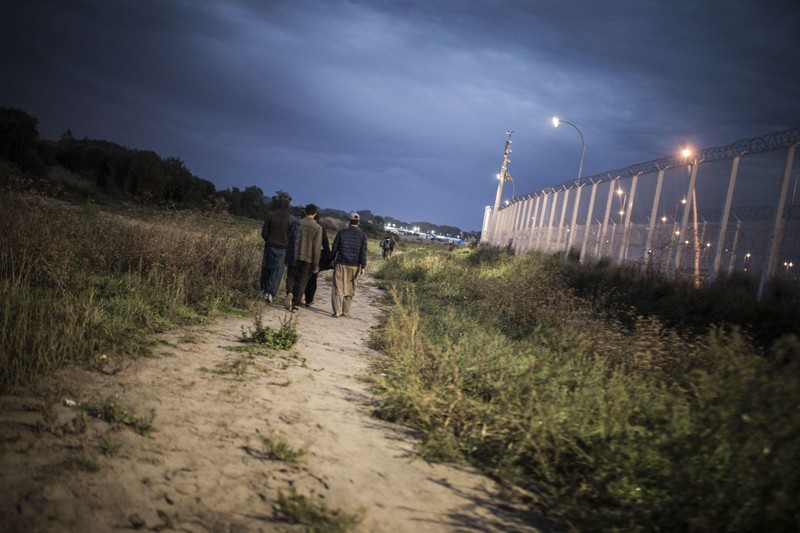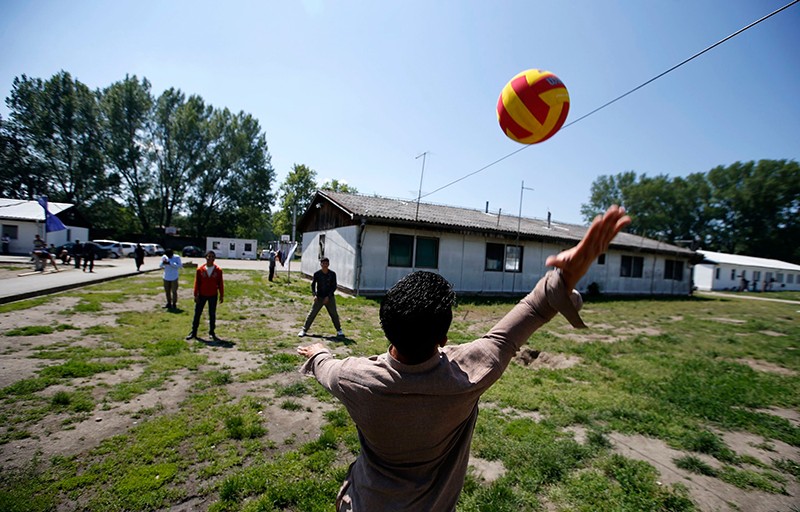(원문: 여기를 클릭하세요~)
연예인들이 나오는 토크쇼를 보다 보면 자신의 나이가 실제와는 다르다고 깜짝 고백해 팬들을 놀라게 만드는 경우가 있습니다. ‘아르헨티나여, 날 위해 울지 말아요’라는 곡으로 잘 알려진 에바 페론은 정치적 이유로 실제 나이보다 어리다고 주장했었습니다. 월트 디즈니가 가난한 생활에서 벗어나기 위한 수단으로 군대에 가기 위해 실제보다 나이가 많은 것으로 속였다는 사실은 잘 알려져 있습니다.

유럽 각국은 유엔의 권고대로 나이를 기준으로 난민에게 구호 서비스를 제공하고 있다. 그러나 몰려드는 난민과 이들의 정확한 나이 파악에 어려움을 겪고 있는 유럽 국가들은 난민들의 정확한 나이를 파악하기 위해 후성유전학적 기법까지 도입하려 하고 있다.Bayer research 제공
스포츠 분야에서는 좀더 좋은 성적을 위해 나이를 오히려 올리는 경우도 많습니다. 중국 체조 대표팀이 2000년 호주 시드니올림픽 당시 만 14세에 불과한 여자 체조선수의 나이를 16세로 속여 출전시킨 사실이 뒤늦게 적발돼 단체전 동메달을 박탈당한 것이 대표적입니다. 국제축구연맹(FIFA)은 경기에 참가하는 축구선수들의 정확한 생물학적 나이를 체크하기 위해 손목뼈 검사를 수시로 실시하고 있다고도 합니다. 뼈나이를 측정하는 손목 스캐닝은 비교적 간단하게 생물학적 나이를 확인할 수 있는 방법이지만 오차 범위가 커서 신뢰도가 떨어진다고 알려져 있습니다. 이 때문에 연구자들은 정확한 나이를 파악할 수 있는 다양한 방법들을 고민하고 있습니다.
최근 유럽 과학자들은 환경 등 후천적인 요인으로 인한 DNA 변화를 찾는 후성유전학적 방법으로 연령을 파악하는 방법을 개발하는 데 주력하고 있습니다. 세계적인 과학저널 ‘네이처’ 4일자에 따르면 연구자들이 신뢰성 높은 증거 기반 검사법인 후성유전학적 기법을 개발하는 이유는 현재 유럽 각국에서 사회문제로 나타나고 있는 ‘난민’ 대책에 도움을 주기 위해서입니다. 현재 유엔에서는 회원국들에게 “18세 미만의 난민들에게는 특별한 보호와 지원을 제공해야 한다”는 규정을 지키도록 권고하고 있습니다. 일부 난민들이 이런 관용적 혜택을 누리기 위해 ‘실제 나이보다 어리다’고 주장하면서 유럽 각국 정부는 최우선적으로 도움을 받아야 하는 대상자를 결정하는 데 어려움을 겪고 있다고 합니다. 일부 극렬 매체들은 이런 사례들만 모아 보도하면서 대중들의 난민들에 대한 혐오증과 폭력까지 부추기고 있는 것이 상황이랍니다.
연구자들은 ‘후성유전학 시계’라는 분자 검사를 이용해 기존 방법보다 좀더 정확하고 빠르게 생물학적 나이를 파악할 수 있다고 주장하고 있습니다. 미드 ‘CSI’에서 흔히 봤던 장면처럼 입안을 면봉으로 슥 문지르는 것만으로도 분석이 가능하다고 합니다. 이런 후성유전학적 기법으로 나이를 예측할 때 오차는 1~2년에 불과하다고 합니다. 기존 뼈 스캔을 통한 해부학적 검사에서 나타나는 오차 범위는 3~4년이기 때문에 훨씬 신뢰성이 높다고 볼 수 있습니다. 물론 후성유전학 시계 검사법으로도 어떤 사람의 나이가 17살 11개월인지 18살인지를 정확히 예측하지 못한다는 한계는 분명히 있습니다.
새로운 과학적 기법을 사용할 때는 항상 윤리적 문제가 동반될 수밖에 없습니다. 후생유전학 기법을 활용한 난민 나이 측정에 대해서도 다른 한편에서는 과학의 이름으로 자칫 한 사람의 삶을 송두리째 바꾸는 상황이 벌어질 수도 있는 만큼 검사 대상자의 완벽한 동의와 프라이버시 보호가 반드시 수반돼야 한다고 주장하고 있습니다. 사실 유럽에서는 범죄자 대상 DNA 검사를 할 때도 개인의 질병 여부 같은 은밀한 정보는 수집할 수 없도록 하고 있습니다. 범죄자에게도 허용되는 인권을 우리와 다른 타자라고 해서 허용하지 않겠다고 한다면 모순 아닐까요.
https://www.nature.com/articles/d41586-018-06165-y?utm_source=feedburner&utm_medium=feed&utm_campaign=Feed%3A+nature%2Frss%2Fcurrent+%28Nature+-+Issue%29
Molecular test of age highlights difficult questions
From forensics to sporting events, disputed age is a source of tension.
A better way to determine age could defuse political tension about treatment of refugees.Credit: Barbaros Kayan/MOKU/SIPA/Shutterstock
Eva Perón claimed she was younger for political reasons. Walt Disney pretended to be older to sign up for war. All sorts of people lie about their age for all sorts of reasons, and they’ve been doing so for a long time. Scandals over the past decade have forced authorities to act on false claims from footballers: the world governing body FIFA now routinely scans the wrist bones of players entering youth competitions to check that the athletes are truly young enough to compete.
Wrist scanning is one of several anatomical tests available that claim to be able to determine an individual’s maturity. They are cumbersome and unreliable. More-accurate tests are on the way. But the implications are profound, and must be discussed by researchers, policymakers and the public.
One reason that scientists are trying to improve age testing is to address controversy in Europe over the age of refugees. United Nations rules say that those under 18 years old must receive particular protection and assistance. Some adults say they are younger than they are to claim these benefits, and tabloid anger over these rare cases has fuelled political and public intolerance.
If officials who assess age on the basis of physical attributes such as height, voice and facial features suspect that a refugee is concealing their true age, they can apply tests that assess the maturity of teeth or bones.
Experts are right to condemn these techniques as being unreliable and to complain they could deny vulnerable children the help afforded to them in national laws. Could a more-reliable and evidence-based test help? Such a test would not answer all the questions posed by Europe’s refugee crisis; almost four million people have claimed asylum since 2014, sparking a rise of xenophobia in parts of society and creating difficult decisions about how best to help immigrants and who to help most. But accurate tests could, in theory, help to make the basis of these decisions objective and transparent.
As we report in a News story, some scientists say that age could be determined more accurately using a molecular test called an epigenetic clock. It looks for distinctive chemical marks that are known to steadily accumulate on DNA. In theory, the test could be performed on a simple cheek swab. The researchers developing it are confident that this method could reliably predict age to within one or two years — much better than the currently used anatomical tests, which can estimate only to within three or four years. But they also highlight that the epigenetic clock currently performs poorly for many people. And no biological test will ever be able to say for sure if a person is 17 years, 11 months or 18 years old.
Such assays must be subjected to extensive, rigorous testing across different populations, and their limitations must be made clear. Furthermore, the ethical implications should be fully debated before the tests are used to determine the age of refugees, which potentially has life-changing consequences. Such tests must always come with full consent and privacy safeguards.
There are also important implications in other spheres. A more accurate way to determine age would be useful in forensics work, for example, to help build up a profile of a suspect from blood or semen. Success would depend on the sample being large enough for analysis. What’s more, countries such as Germany currently prohibit such information being extracted from DNA tests.
Age fraud is a widespread problem in sport. In 2010, the discovery of such deception forced a Chinese gymnastics team to return the gold medals it had won at the Sydney Olympics a decade earlier. One competitor was declared to have been only 14 at the time of the competition, two years below the required age.
Last week saw violent anti-immigrant demonstrations, this time in Chemnitz in eastern Germany. Even though the number of refugees arriving in Europe has plummeted — 49,000 had arrived by this July, compared with 1.3 million throughout 2016 — tensions remain high.
Given all this, researchers should not develop, or make claims for, age-determining tests without extreme care and wide discussion. That will take time: time for the rest of society to ponder how and whether such tests should be used. Age is not just a number. Much can be at stake.
Nature 561, 5 (2018)
https://www.nature.com/articles/d41586-018-06121-w?utm_source=feedburner&utm_medium=feed&utm_campaign=Feed%3A+nature%2Frss%2Fcurrent+%28Nature+-+Issue%29
Can epigenetics help verify the age claims of refugees?
European scientists say that a more accurate test could help to implement laws that protect minors seeking asylum.
Migrants pass through Belgrade en route to western Europe.Credit: Nemanja Pancic/SIPA/Shutterstock
When local authorities in Hildesheim, Germany, didn’t believe an asylum seeker who claimed to be under 18 years old — and thus eligible for privileged treatment — police turned to a blood-based age test sold by a California company.
The test, offered by Zymo Research in Irvine, uses chemical modifications to DNA that accrue over a lifetime, called an ‘epigenetic clock’, to determine a person’s age. Forensic scientists — aware of its potential benefits but also of its current lack of precision — sounded an alarm.
In a paper published online1 in May, a team led by forensic-medicine specialist Stefanie Ritz-Timme of the University of Dusseldorf in Germany said that these tests were not ready for use in sensitive forensic evaluations.
But now, in the charged political atmosphere that has accompanied the arrival of millions of refugees to Europe, forensic scientists across the continent are joining forces to improve epigenetic-clock-based tests — with a focus on whether they might be used to help determine the age of refugees whose claims to be under 18 are disputed. They hope that, with time, such tests could replace existing methods, which assess the maturity of bones or teeth to determine an individual’s age but are imprecise, and can be controversial.
“The race is now on to develop a more accurate clock that would be more predictive than the anatomical tests — and also more practical for use in forensic science,” says cell biologist Wolfgang Wagner at the University of Aachen, Germany. He has teamed up with other German forensic scientists to overcome these challenges, not only for the test’s use on refugees, but also for other forensic uses.
A call for sensitivity
The development of scientific methods that could feed into decisions about who is granted asylum and how refugees are treated are likely to elicit criticism, says Denise Syndercombe-Court, a forensic geneticist at King’s College London. She says that some scientists, herself included, are wary of these efforts.
But Niels Morling, a forensic geneticist at the University of Copenhagen who is running a national epigenetic-clock programme, defends the development of tests that are more accurate. Given that the law treats those under 18 very differently from adults, he says, then “you have a duty to make sure that it can be implemented fairly”.
Philosopher Thomas Pogge, who specializes in global justice at Yale University in New Haven, Connecticut, says that to keep rising anti-immigration sentiment in check, it is important for authorities to show that they can detect any refugees who pretend to be younger than they are.
Since 2014, Europe has received around 4 million refugees, many of whom arrived without identity documents. More than 1.5 million refugees have sought asylum in Germany, around one-third of whom are registered as minors. In Europe, minor status usually leads to better care and an increased chance of being granted asylum. Minors also have a higher chance than adults of gaining permission for family members to join them. And, if convicted of a crime, people under 18 usually receive shorter sentences — served in special prisons for juveniles.
Risky tests
Authorities say that, because of the benefits, some unaccompanied refugees claim to be younger than they are. But the anatomical tests that are currently used to assess age have an error range of up to 3–4 years, and rely on X-rays and magnetic resonance imaging. In countries such as Norway, refugees have sued the authorities for being forced to submit to these medical tests.
The publication of the first reasonably accurate epigenetic clock in 2013 presented a simpler way of verifying age, because it could be carried out using blood samples2. Developed by biostatistician Steve Horvath at the University of California, Los Angeles, this clock measures an epigenetic mark called methylation at 353 DNA sites across the genome.
Horvath’s paper was based on data from thousands of individuals. He analysed the genomes of different cell types — from blood to heart and brain cells — and identified the modifications that both correlated best with age and were least subject to environmental influences such as diet, which can alter epigenetic modifications. The clock’s accuracy varies between cell types, and diseases such as cancer can throw it off kilter.
But in blood, the median error was 2.7 years, meaning that it could predict the age of half the donors to within 32 months — a similar accuracy to that of the X-ray-based methods. And Horvath’s clock proved particularly accurate in children and adolescents — including those around the legally crucial age of 18.
Refugees who are children receive privileged treatment.Credit: AP/Shutterstock
Horvath has since refined the method. In July, he published a new clock that measured epigenetic marks at 391 DNA sites in different tissues3. It was particularly accurate in buccal cells scraped from the inside of the cheek, which are easier to collect than blood samples. Testing these buccal cells from 53 people aged between 3.5 and 18 years, he found a median error of just 1.03 years. However, there were many outliers — people whose age could not be accurately predicted — and the most extreme result was out by 5 years and 8 months. Horvarth anticipates that epigenetic-clocks, once refined, will help refugees by corroborating their age claims. “At the same time, the tests may help identify individuals who break the law,” he adds.
In the Hildesheim case, Zymo, which bought an exclusive licence to Horvath’s test in 2016, compared the refugee’s sample with those of five others who had similar ethnic backgrounds and whose ages were known. Keith Booher, project manager for Zymo’s epigenetic services, told Nature that the test determined the most likely age of the person to be between 26 and 29 years old. Hildesheim authorities have declined to comment on the case.
Zymo charges around US$300 for a blood sample, and each test requires multiple samples. Forensic scientists around Europe are now working to make an epigenetic clock that would be more accurate and less expensive than what is available – and is also applicable to the easily-collected buccal cells. That means working out the minimum number of DNA sites needed to ensure the greatest accuracy, says forensic geneticist Peter Schneider of the University of Cologne in Germany. He predicts that just 10 or 20 markers will suffice.
Ethnic differences
Studies are also under way to gauge how the diverse ethnic backgrounds of Europe’s refugees might influence the epigenetic clock. Schneider’s team conducted a preliminary study4 into the relationship, which suggests the effect could prove to be limited. The researchers found that the epigenetic modifications for which the clock tested were broadly similar across populations hailing from Central Europe, the Middle East and West Africa.
Another challenge of using the epigenetic clock is dealing with the statistical outliers. A recent study5 of more than 1,000 British 17-year-olds born in the 1990s found that the clock measured a pleasing median age of 17.2 years — yet it judged some to be under 4 years old and others over 30.
Such outliers may in some cases be explained by undiagnosed illnesses that distort the clock, or by technical errors. Wagner thinks that some of these people, for whom the method simply won’t work, could be identified using the right combinations of epigenetic markers, allowing scientists to discount the test’s results. And with better mathematical models for setting the epigenetic clock, along with improved sequencing technologies for identifying epigenetic marks, it might be possible to get the test’s margin of error well down, he says.
But even if the accuracy of the epigenetic clock cannot be improved to the point where it can replace anatomical tests, it would still be attractive, says Morling. “Every time you add a new method, you improve overall precision of age estimation.”
Nature 561, 15 (2018)


